Spokane, Washington
| City of Spokane | |||
 |
|||
|
|||
| Nickname(s): The Lilac City | |||
| Motto: Near Nature. Near Perfect. | |||
 Spokane County and Washington |
|||
| Coordinates: | |||
| Country | United States | ||
|---|---|---|---|
| State | Washington | ||
| County | Spokane | ||
| Government | |||
| - Type | Mayor-Council/Strong Mayor | ||
| - Mayor | Mary Verner | ||
| Area | |||
| - City | 58.5 sq mi (151.6 km²) | ||
| - Land | 57.8 sq mi (149.6 km²) | ||
| - Water | 0.8 sq mi (2.0 km²) 1.3% | ||
| Elevation | 2,376 ft (724 m) | ||
| Population (April 1, 2008 [1]) | |||
| - City | 204,400 | ||
| - Density | 3,387.0/sq mi (1,307.7/km²) | ||
| - Metro | 459,000 | ||
| Time zone | PST (UTC-8) | ||
| - Summer (DST) | PDT (UTC-7) | ||
| Area code(s) | 509 | ||
| FIPS code | 53-67000[2] | ||
| GNIS feature ID | 1512683[3] | ||
| [4][5] | |||
| Website: www.spokanecity.org | |||
Spokane (pronounced /spoʊˈkæn/) is the largest city and county seat of Spokane County, and is the metropolitan center of the Inland Northwest, a region consisting of Eastern Washington, Idaho, & Montana. It is located on the Spokane River in Eastern Washington approximately 20 miles (32 km) from the Washington-Idaho border, and 275 miles (443 km) east of Seattle.
The city was settled in 1871 as "Spokan Falls" (without an 'e' at the end), drawing on the Native American tribe known as the Spokane, which means "Children of the Sun.”[6] The city's name is often mispronounced "Spo-CAIN", while the correct pronunciation is "Spo-CAN". Spokane's official nickname is the 'Lilac City', named after the flowers that have flourished since their introduction to the area in the early 20th century.
With a population of 204,400 [7] Spokane is the second largest city in Washington, and the third largest in the U.S. Pacific Northwest, behind Seattle and Portland. Spokane is also the principal city of the Spokane Metropolitan Statistical Area, which is coterminous with Spokane County and has a population of 459,000. However, combine with Coeur d'Alene, Idaho and Kootenai County, Idaho the Spokane-Coeur d'Alene area consists of about 600,000 people.
Contents |
History
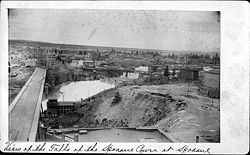
Spokane Falls was a gathering place for the area's indigenous people due to the abundance of salmon in the Spokane River. The first European settlement at Spokane Falls was a fur trading post operated by the British North West Company and, later, the Hudson's Bay Company. Known as "Spokane House", or just "Spokane", and located just below Spokane Falls, it was in operation from 1810-1826.[8] After the North West Company was absorbed into the Hudson's Bay Company the operations at Spokane House were shifted to Fort Colville, although the Company remained active in the Spokane region.[9] The first American settlers came in 1871. They were two squatters named James J. Downing and Seth Scranton who built a small sawmill on a claim located near the south bank of the Spokane Falls. James N. Glover and Jasper Matheney, two Oregonians who were passing through the region recognized the value of the Spokane River and its falls. Glover and Matheney also knew that the Northern Pacific Railroad Company had received a government charter to build a main line across this northern route and in 1873 they purchased the sawmill and the claim from Downing and Scranton.[10] In 1876 Glover bought out his partner Matheney and opened Spokane's first bank. Glover is considered the founding father of Spokane and later became one of its first mayors as well.
Camp Spokane was established by the U.S. Army at a location 56 miles (90 km) northwest of Spokane on October 21, 1880 to protect the construction of the Northern Pacific Railway, and to secure the location for U.S. settlement. By 1881, the Northern Pacific Railway was completed at this point, bringing European settlement. The city of Spokan Falls (without an 'e'; the 'e' was added in 1883) was officially incorporated on November 29, 1881.[11] In 1891, the name was changed to Spokane.[12]
The Great Fire
In the summer of 1889, a fire destroyed the city's downtown commercial district. Due to technical problems with a pump station, there was no water pressure in the city when the fire started. When volunteer fire fighters attempted to quench the flames, they found their hoses were unusable. Eventually winds died down and the fire exhausted of its own accord. 27 blocks of Spokane's downtown were destroyed.
While the damage caused by the fire was a devastating blow, Spokane continued to grow. Just three years after the fire, in 1892, the Great Northern railroad reached Spokane and built a rail yard that made Spokane a transportation hub for the area. The first rail yard, built by James J. Hill, was completed in 1902. The clock tower currently in Riverfront Park was built as part of the depot and is one of the biggest in the Northwest, with each of its clock faces measuring 9 feet (2.7 m) across. The clock tower is the only part of the depot that remains standing to this day.
1974 World's Fair
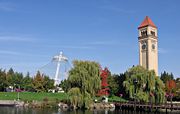
Spokane hosted the first environmentally themed World's Fair in Expo '74, becoming the then-smallest city to ever host a World's Fair. This event transformed Spokane's downtown, removing a century of railroad industry that built the city and reinventing the urban core. The famous spokane clock tower was part of a train station. You can see where bricks were added on and where the roof used to be.
Many of the structures built for the World's Fair are still standing and in use. The United States Pavilion sits next to an IMAX theater, and the Washington State Pavilion became the INB Performing Arts Center. The Expo site itself became the 100-acre (0.40 km2) Riverfront Park, containing, among other features, the U.S. Pavilion, the turn-of-the-20th-century (and meticulously preserved) Looff Carousel, and the Great Northern Railway clock tower, the last remnant of the vast rail depot that was demolished for Expo '74. The U.S. Pavilion and the clock tower are prominently featured in the park's logo.
Downtown Urban Renewal
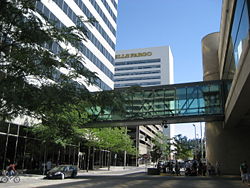
Downtown Spokane has undergone a major rebirth in recent years after the completion of River Park Square Mall. The historic Davenport Hotel underwent a major renovation in 2002 after being vacant for over 20 years. The project was funded by local entrepreneur Walt Worthy, who also added a Safari-themed 20 story tower to the hotel in 2007. Other major projects include the renovation of the Holley Mason Building, the building of the Big Easy concert house (now renamed the Knitting Factory), the renovation of the Montvale Hotel and the historic Fox Theater (now home to the Spokane Symphony after its renovation), numerous new condo buildings, and renovations of historic, older brick buildings that will house both condos and business. Also, the Spokane Convention Center just finished a major expansion which helped host the 2007 US Figure Skating Championships. All new skyscrapers built in Spokane are subject to city height restrictions. Recently, a local developer (Rob Brewster) has proposed building the new VOX Tower which, if approved, will become the tallest building in Spokane. In all, over 500 projects worth over 2 billion dollars are taking place in downtown. [3]
Since February 2005 the Spokane metro area has seen an influx of new residents, drawn to the region by its natural beauty, its wealth of recreational activities, good weather, and its relatively low cost of living and vibrant job market. Spokane was #49 on the Men's Journal 2006 "50 Best Places to Live" list,[13] #5 on the Forbes Magazine 2005 "Safest Places to Live" list,[14] and #35 on the Inc. Magazine 2005 "Top US Cities for Doing Business" list.[15]
Kendall Yards
The new Kendall Yards development on the northside of Downtown Spokane along the Spokane River will become one of the largest construction projects in the city's history. The proposed development will directly connect to downtown with bridges across the Spokane River and blends residential and retail space with plazas, and walking trails. Phase I of the development will incorporate about 500 residential units and 500,000 square feet (50,000 m2) of non-residential use. Town homes, condominiums, and apartments will comprise the residential makeup. Upon completion, the nearly 80-acre (320,000 m2) Kendall Yards project will include up to 2,600 residential units and up to 1,000,000 square feet (93,000 m2) of commercial, retail and office space. [4]
Spokane and its metropolitan area
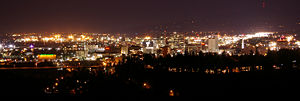
Spokane is located at . The City of Spokane covers an area of 58.5 sq mi (151.6 km²). Spokane is surrounded by many unincorporated communities (and several incorporated cities), which make up the suburbs of Spokane. They include Airway Heights, Cheney, Mead, Colbert, Spokane Valley, Millwood, Nine Mile Falls, Otis Orchards and Liberty Lake. Across the border in Idaho, are Post Falls and Coeur d'Alene.
Neighborhoods
Much of Spokane is reflected in its large variety of neighborhoods. Neighborhoods range from the Victorian-era style South Hill & Browne's Addition, to the Davenport Arts District of Downtown, to the more contemporary neighborhoods of North Spokane. Virtually every social class is represented. Some of the neighborhoods are officially recognized by the city, while others are not, but are commonly thought of as distinct neighborhoods by residents.
Spokane's neighborhoods are gaining attention for their charm and character, as illustrated by the city being home to 18 recognized National Register Historical Districts, the most of any city in the Northwest. [5] The districts include: Browne’s Addition, Corbin Park, East Downtown Historic District, Fort George Wright, Four Corners, Hillyard Historic District, Marycliff-Cliff Park, Mission Avenue, Nettleton's Addition, Ninth Avenue, Peaceful Valley, Riverside Avenue, Rockwood, Desmet Avenue Warehouse, and the West Downtown Historic Transportation Corridor.There are also more than 1,300 individual properties on the National Register in Spokane County.
Geography and climate
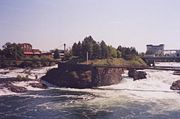
Spokane is located at the eastern edge of the Columbia Plateau's wheat farms and steppe, where they meet the forested Rocky Mountain foothills, the Selkirk Mountains. The Spokane River, a major tributary of the Columbia River, passes through the city, tumbling through a series of falls in the middle of downtown.
Downtown Spokane is at an elevation of about 1,890 feet (576 m) above sea level, while the rest of the city varies by nearly 1,000 feet (300 m). The lowest elevation in the city of Spokane is the northernmost point of the Spokane River in Riverside State Park within city limits at 1,608 feet (490 m). (As a state park, its territory continues further downstream.) This is located next to the 7900 block of Aubrey L. White Parkway. The highest elevation is on the northeast side near the community of Hillyard, though closer to Beacon Hill and the North Hill Reservoir at 2,591 feet (790 m). As both extremes are located on city boundaries, any further annexations in these areas will likely result in a revision.
Spokane has the quintessential four-season climate, being in the continental and semi-arid zone. The area is known for its total days with sun. Summers are pleasantly warm and sunny with high temperatures usually between 80 and 90 °F (32 °C). Low humidity and cool evening temperatures make summers in this region both comfortable and desirable. Winters are marginally cold, averaging 40.6 inches (103 cm) of snow per year. The Cascade Mountains to the west shield the city from the direct modifying effect of Pacific Ocean air, giving the region 70% more sunny days and less than half the rainfall of its west side neighbor Seattle. The Rocky mountains to the east help to protect it from the worst effects of Arctic air in winter, and precipitation is concentrated in the cooler half of the year, with the summer having dry and stable weather.
| Month | Jan | Feb | Mar | Apr | May | Jun | Jul | Aug | Sep | Oct | Nov | Dec | Year |
|---|---|---|---|---|---|---|---|---|---|---|---|---|---|
| Average high °F (°C) | 32 (0) |
39 (4) |
47 (8) |
57 (14) |
66 (19) |
79 (26) |
83 (28) |
82 (28) |
73 (23) |
58 (14) |
41 (5) |
33 (1) |
54 (12) |
| Average low °F (°C) | 20 (-7) |
25 (-4) |
29 (-2) |
35 (2) |
43 (6) |
49 (9) |
55 (13) |
54 (12) |
46 (8) |
36 (2) |
29 (-2) |
22 (-6) |
37 (3) |
| Precipitation inches (mm) | 2.5 (63.5) |
1.5 (38.1) |
1.5 (38.1) |
1.1 (27.9) |
1.5 (38.1) |
1.3 (33) |
0.6 (15.2) |
0.7 (17.8) |
0.8 (20.3) |
1.2 (30.5) |
2.1 (53.3) |
2.3 (58.4) |
16.9 (429.3) |
| Source: Weatherbase.com[16] {{{accessdate}}} | |||||||||||||
According to the United States Census Bureau, the city has a total area of 58.5 square miles (151.6 km²), of which, 57.8 square miles (149.6 km²) is land and 0.8 square miles (2.0 km²) (1.30%) is water.
Demographics
| Historical populations | |||
|---|---|---|---|
| Census | Pop. | %± | |
| 1890 | 19,922 |
|
|
| 1900 | 36,848 | 85% | |
| 1910 | 104,402 | 183.3% | |
| 1920 | 104,437 | 0% | |
| 1930 | 115,514 | 10.6% | |
| 1940 | 122,001 | 5.6% | |
| 1950 | 161,721 | 32.6% | |
| 1960 | 181,608 | 12.3% | |
| 1970 | 170,516 | −6.1% | |
| 1980 | 171,300 | 0.5% | |
| 1990 | 177,196 | 3.4% | |
| 2000 | 195,629 | 10.4% | |
| Est. 2007 | 200,975 | 2.7% | |
As of the 2008 census[2] estimates, there were 204,408 people,[4] 81,512 households, and 47,276 families residing in the city. The population density was 3,387.0 people per square mile (1,307.7/km²). There were 87,941 housing units at an average density of 1,522.6 per square mile (587.8/km²).
The most recent ethnic percentages as of 2005 [6] are 88.9% White, 4.4% Multiracial, 3.5% Hispanic, 2.5% Asian, 2.0% African American, 1.5% Native American, 0.6% from other races 0.2% Pacific Islander. 20.7% were of German, 10.8% Irish, 9.6% English, 6.8% United States or American and 5.8% Norwegian ancestry according to Census 2000. Ukrainian, Russian and other eastern European immigrants make up around 4% of the White population.
There were 81,512 households out of which 29.4% had children under the age of 18 living with them, 41.3% were married couples living together, 12.4% had a female householder with no husband present, and 42.0% were non-families. 33.9% of all households were made up of individuals and 11.7% had someone living alone who was 65 years of age or older. The average household size was 2.32 and the average family size was 2.98.
In the city the population was spread out with 24.8% under the age of 18, 11.1% from 18 to 24, 29.6% from 25 to 44, 20.5% from 45 to 64, and 14.0% who were 65 years of age or older. The median age was 35 years. For every 100 females there were 93.0 males. For every 100 females age 18 and over, there were 89.9 males.
The median income for a household in the city was $32,273, and the median income for a family was $41,316. Males had a median income of $31,676 versus $24,833 for females. The per capita income for the city was $18,451. 15.9% of the population and 11.1% of families were below the poverty line. 19.3% of those under the age of 18 and 9.6% of those 65 and older were living below the poverty line.
Since February 2005 the Spokane metro area has seen an influx of new residents, drawn to the region by its natural beauty, its wealth of recreational activities, good weather, and its relatively low cost of living and vibrant job market. Spokane was #49 on the Men's Journal 2006 "50 Best Places to Live" list,[17] #5 on the Forbes Magazine 2005 "Safest Places to Live" list,[18] and #35 on the Inc. Magazine 2005 "Top US Cities for Doing Business" list.[19]
Government
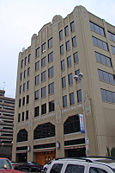
The City of Spokane operates under a Mayor-Council form of government, also referred to as "Strong Mayor." It switched to a Strong Mayor system in January 2001, after 40 years of running under a Council-Manager system.[20]
The current mayor of Spokane is Mary Verner. She was formerly on the city council for four years and became the new mayor on November 27, 2007 replacing Dennis P. Hession, who conceded on November 9th, 2007. Hession became mayor on December 16, 2005 after the recall of the late Jim West. The City Council consists of seven members: two elected from each of three districts, plus a president elected at large. The current City Council President is Joe Shogan.
Spokane is in Washington's 5th congressional district, and is currently represented by 2nd-term Republican Cathy McMorris Rodgers.
See also: List of mayors of Spokane, Washington
Economy
In the late 1800’s, gold and silver were discovered in the Inland Northwest. The area is now considered to be one of the most productive and reformed mining districts in North America.[21] Natural resources have traditionally provided much of the economic activity for the Spokane area, a major center for the timber, agriculture, and mining industries in the region. A number of manufacturing companies have located in Spokane, drawn by the easy access to raw materials and cheap hydroelectric power. Finished wood products, metal refinery and fabrication, and food processing are among the leaders in manufacturing. The outlying areas are part of an abundant agricultural system, providing a large amount of the nation's apples, peas, hops, pears, asparagus, lentils, soft wheat, and sweet cherries. A number of wineries and breweries also operate in the area. These industries continue to be important elements in the local economy, but in recent years the economy has diversified to encompass high-technology and service companies. Health-related industries employ more people than any other industry in Spokane. The city provides specialized care to many patients from the surrounding areas, as far north as the Canadian border. Spokane serves as the hub for the service industries, and the wholesale and retail trade center of the 80,000-square-mile (210,000 km2) Inland Northwest region.
In part because Spokane is the largest city between Seattle and Minneapolis, tourism is also on the rise in the area. Downtown Spokane has become a shopping center of the inland northwest, with new malls such as River Park Square. Several ski resorts are located in the area, including world-class Schweitzer Mountain Resort in Sandpoint, Idaho and Silver Mountain Resort in Kellogg. Spokane also serves as a "base camp" for activities such as river rafting, camping, and other activities.
The educational services industry employed the most workers in 2002 with more than 17,000 jobs.[22] Other productive industries include construction and mining, manufacturing, transportation, communication and networking utilities, finance, insurance, real estate, health care, and government.[23]
Advocating for regional economic growth in workforce, industry, manufacturing, public policy, and healthcare is Greater Spokane Incorporated, a joint organization consisting of the former Chamber of Commerce and the former Economic Development Council.[24]
Education
Spokane Public Schools (District 81) is the main and largest public school system in Spokane, serving roughly 30,000 students. Two other significant public school districts in the Spokane area are Central Valley School District, and Mead School District, serving approximately 12,000 and 9,100 students, respectively.
Spokane is home to many higher education institutions. They include the private universities, Gonzaga and Whitworth, and the public Community Colleges of Spokane system. While Spokane is one of the larger cities in the U.S. to lack a main campus of a state-supported university within its city limits, Eastern Washington University (EWU) and Washington State University (WSU) have operations at the Riverpoint Campus (formerly known as "Riverpoint Higher Education Park"), just adjacent to downtown. The campus is also home to the Spokane Intercollegiate Research and Technology Institute (Sirti) and, as of fall 2008, the University of Washington's Schools of Medicine and Dentistry will have first-year students at the Riverpoint Campus in partnership with WSU and EWU.
The main EWU campus is located 15 miles (24 km) southwest of Spokane in Cheney, and WSU is located in Pullman about 65 miles (105 km) to the south.
Serving the general educational needs of the entire local population are two public library districts, the Spokane Public Library and the Spokane County Library District.
Infrastructure
Healthcare
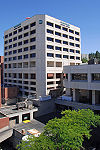
Spokane is the hub for medical services in the Inland Northwest. The region's healthcare needs are served primarily by Seattle-based Providence Health & Services and Spokane-based Empire Health Services, two non-profit organizations who run the two biggest hospitals in Spokane, Sacred Heart Medical Center, and Deaconess Medical Center, respectively. Both hospitals are Level II trauma centers and work together by alternating weeks of being the designated trauma center in the area. The two hospitals, along with a majority of Spokane's major health care facilities are located on Spokane's Lower-South Hill, just south of Downtown. The close proximity of the hospitals and many doctors offices and specialized clinics scattered around this area, form what is known as the "Medical District" of Spokane.
Healthcare in Spokane is considered excellent, and the level of service attracts patients from beyond the region. Deaconess Medical Center has been ranked one of the Top 100 Heart Hospitals in the nation 5 times in the last 8 years by Solucient, and is ranked #1 in Washington for overall cardiac services by HealthGrades.[25]
In 2003, Sacred Heart Medical Center opened the first and only major Children's Hospital in Eastern Washington.
Other hospitals in the area include the Spokane VA Medical Center (Department of Veterans Affairs, northwest part of town), Holy Family Hospital (on the north side), and Valley Hospital and Medical Center (in the Spokane Valley).
Transportation
Roads and Highways
For its city streets, Spokane uses the very common street grid that is oriented to the four cardinal directions; north, south, east, and west. The median streets are Division St. (running north-south, dividing east and west), and Sprague Ave. (running east-west, dividing north and south).
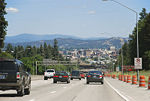
Spokane is primarily served by Interstate 90, which runs east-west from Seattle, through Downtown Spokane, and eastward through Spokane Valley, Liberty Lake, and onward to Coeur d'Alene. Although they are not limited access highways like I-90, US 2 and US 395 enter Spokane from the west via I-90 and continue north through Spokane via Division St. The two highways share the same route until they reach "The Y", where US 395 continues northward to Deer Park, and US 2 branches off to the northeast, continuing to Mead, Colbert, Chattaroy, Newport, and Sandpoint.
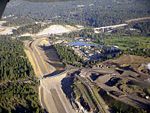
Over the past decade, the Washington State Department of Transportation (WSDOT) has aggressively improved local highways to keep up with the region's growth and to try to prevent congestion problems that plague many large cities around the country. In 2005, the WSDOT completed the first two phases of its I-90 Spokane-Idaho State Line widening project. Currently the Interstate has been widened to six lanes through Spokane Valley, but another $166 million in funding is still needed to widen the last segment between Sullivan Road and the Idaho state line.[26]
The Department of Transportation is also constructing the US 395 North Spokane Corridor. When completed, the corridor will be a brand new 10.5-mile (16.9 km) long limited access highway that will run from I-90 in the vicinity of the Thor/Freya interchange northward through Spokane, meeting the existing US 395 just north of Wandermere. Aside from the construction of I-90 itself, this is the largest road construction project ever to be implemented in Spokane. The north-south freeway is expected to take over $2 billion to complete (over $3 billion if inflation is factored in). The first segment of the freeway is scheduled to be open in 2009. The rest of the freeway will be built when funding is available. With full funding, the roadway is expected to take 10 years to complete.
Public transportation
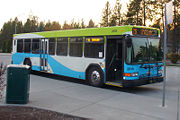
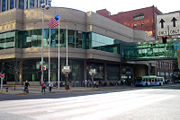
Before the influx of automobiles, people got around by using Spokane's streetcar system. Many of the older sidestreets in Spokane still have visible streetcar rails embedded in them to this day, as they were never removed.
Today, mass transportation throughout the Spokane area is provided by the Spokane Transit Authority (STA). STA currently operates approximately 160 buses and has a service area that covers roughly 371 square miles (960 km2). A large percentage of STA bus routes originate from the central hub, the STA Plaza, in Downtown Spokane. Passengers who stop at The Plaza can transfer to virtually any other of Spokane Transit's routes.
In the late-1990s, talk of constructing a rapid-transit system became popular. Although bus rapid transit was considered, constructing a light rail system was the preferred alternative. The proposed light rail line was to run from The Plaza eastward through the Spokane Valley to Liberty Lake, with future extensions from The Plaza to Spokane International Airport, Liberty Lake to Coeur d'Alene, Idaho, and a line running in the median of the currently-being-constructed, North Spokane Corridor. In 2005, the $263 million project was narrowly defeated by voters, shelving the project for the time being. A non-profit, non-partisan citizens group, The Inland Empire Rail Transit Association (also known as InlandRail), was created to continue the public dialog.[27]
Spokane has rail and bus service provided by Amtrak and Greyhound via the Spokane Intermodal Center. The city is a stop for Amtrak's Empire Builder on its way from Chicago. Through service continues once a night to both Seattle and Portland, Oregon, a reflection of the old Spokane, Portland and Seattle Railway.
Airports
Spokane, Eastern Washington and North Idaho are served by Spokane International Airport GEG [7], which has no international flights (except to Canada), but is still the second largest airport in the state of Washington. The airport lies west of the city, and is a 10 minute drive to downtown. The international airport three letter designation is GEG, a result of the legacy Geiger Field days. Geiger is now a National Guard landing field and general aviation.
Felts Field is a general aviation airport serving Spokane County and is located in east Spokane along the Spokane River. Felts Field served as Spokane's primary airport until SIA was built. Today the terminal building, among others at the airport, still stand and are listed on the National Register of Historic Places.
Culture and contemporary life
Life in Spokane is heavily influenced by its climate and location on the map. Spokane experiences a four-season climate, and is close in proximity to dozens of lakes and rivers for swimming, boating, and fishing, as well as mounatins for skiing, hiking, and biking. As a result, Spokane can be characterized as an "outdoorsy" city.
In addition to being an outdoorsy city, Spokane, being a medium sized city is big enough to support urban culture (such as Broadway performances, shopping and dining, etc.) that compares to larger cities, but at the same time is small enough to support annual events and traditions that have a hometown feel attached to them.
Arts and Theater
Spokane boasts a substantial amount of different visual and performing arts scenes.
One of the most notable events is the First Friday Artwalk, which occurs the first Friday of every month, and is dedicated to local vendors and performers displaying art around Downtown. Spokane's two main Artwalk dates (the first Friday of February and October) attract large crowds to the art district. Spokane's main art districts are located in the Davenport District, the Garland Village, and a recently formed art district in 1800 E. Sprague area. In addition, Spokane is home to a numerous amount of art galleries, many of which are in the Davenport District.
The Davenport District is also home to many of the Spokane's main performing arts venues. Goodworks Co-op, beneath the infamous Ella's Supper Club, which projects silent black and white movies on the back of the Fox Theater each night.
- The Fox Theater recently re-opened, restored almost to its exact original Art Deco state. This establishment seats more than the Bing Crosby Theater.
Sports
Spokane's professional sports teams include the Spokane Shock (af2), Spokane Indians (Northwest League), Spokane Chiefs (Western Hockey League), and the Spokane Spiders (Premier Development League).
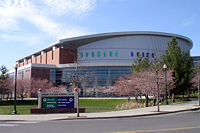
In 1995, the Spokane Public Facilities District opened Spokane's premier sports venue, the Spokane Veterans Memorial Arena to replace the Spokane Coliseum. In the years since Spokane Arena opened, it along with the City of Spokane have played host to major sporting events.
One of the first major events hosted occurred in 1998, that event being the Memorial Cup, the championship game of the Canadian Hockey League. Four years later in 2002, Spokane hosted the 2002 Skate America figure skating competition as well as the first two rounds of NCAA Division I Women's Basketball Tournament. In 2003 and 2007 the NCAA returned to Spokane with the Division I Men's Tournament, and again in 2008 with the Women's tournament.
The biggest sports event hosted in Spokane history was the 2007 U.S. Figure Skating Championships. The event set an attendance record, selling nearly 155,000 tickets and passing the previous mark of 125,000 set by the Los Angeles and was later named the Sports Event of the Year by Sports Travel Magazine.[28], beating out notable events, including Super Bowl XLI, among others. Fans, analysts and athletes, including Ice Dancing champion Tanith Belbin, spoke highly of the city's performance as host, which included large, supportive crowds. Spokane was also a candidate city for the 2009 World Figure Skating Championships, losing its bid to Los Angeles. Skating analyst Dick Button said that Spokane should host that event in the future. On May 5, 2008, it was announced that Spokane will once again host the U.S. Figure Skating Championships in 2010 - ending 18 days before the start of the 2010 Olympics in Vancouver.
During basketball season, one of the toughest tickets in town is to see the Gonzaga University Bulldogs, who regularly sell out their home games in the recently built McCarthy Arena on the Gonzaga campus, just north of downtown.
The Spokane Arena is also the perennial host to the State 'B' Basketball Tournament, which brings athletes and fans from many of Washington's smaller high schools to town. With the split of the 'B' classification in 2006, beginning in 2007 the city will be host to the State 2B (the state's second smallest class) Basketball Championships.
The Spokane Chiefs are the 2008 WHL and Memorial Cup champions.
The Spokane Indians are the 2008 Northwest League champions having defeated the Salem-Keiser Volcanoes 3 games to 1.
The city is also home to the Eastern Washington University Eagles athletics.
In addition, Spokane is home to the Lilac City Rollergirls, the city's first all-female flat-track roller derby league.
Parks and recreation
In 1907, Spokane's board of park commissioners retained the services of the Olmsted Brothers to draw up a plan for Spokane parks. Today, Spokane has a system of over 75 parks totaling 3,500 acres (14 km2), with parks ranging in size from the 0.25-acre (1,000 m2) Skeet-So-Mish Park playground to the 464-acre (1.88 km2) Palisades Park conservation area. Some of the parks in Spokane’s extensive park system are listed below:
- Riverfront Park, created after Expo '74 and occupying the same site, is 100 acres (0.40 km2) in downtown Spokane and the site of some of Spokane's largest events. The park has views of the Spokane Falls, and holds a number of civic attractions, including the Skyride (a recently rebuilt gondola that carries visitors across the falls from high above the river gorge), the 5-story IMAX theater, and numerous rides and concessions. Various festivals are held in the park throughout the year. A new "Great Gorge Park," originally designed by the Olmsted Brothers, is being proposed as an extension of Riverfront Park along the deep river gorge through the Peaceful Valley neighborhood.
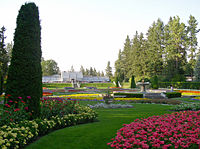 View of the Duncan Garden at Manito Park.
View of the Duncan Garden at Manito Park.
- Manito Park and Botanical Gardens, on Spokane's South Hill, has a duck pond, a central conservatory named in memory of Dr. David Gaiser, Duncan Garden, a classical European Renaissance style garden and the Nishinomiya Japanese Garden designed by Nagao Sakurai.
- Riverside State Park is close to downtown and is a site for hiking, mountain biking, rafting, and also has scenic views.
- The Centennial Trail has over thirty-seven miles of paved trails running along the Spokane River and across the metropolitan area for running, walking, bicycling or inline skating. Informational signs and parking are provided along the trail, which runs from west of Spokane into Idaho.
- Highbridge Park and People's Park: These two parks are located in Peaceful Valley, where it meets Hangman creek.
- Spokane Attractions [8] Spokane has a modest but diverse array of attractions, ranging from the outdoorsy, such as miles of hiking trails and crystalline lakes in parks and outlying natural areas, to more "big-city" enticements like shopping centers and Broadway shows, mostly centered around the city's downtown.
The downtown area of Spokane encompasses a large shopping area, with several square blocks of shops, restaurants and theaters. It is attractively arranged, right on the river, and adjacent to the large and popular Riverfront Park. The Park was the site of Expo '74 World's Fair. It includes a small amusement park (which is converted into an ice-skating rink during the winter months), a restored Louff carousel, an IMAX theater and ample views of the Spokane falls as well as other water features (some man-made) of the Spokane River. The park is host to a full schedule of family entertainment and events such as the Bloomsday Post-Race Celebration, Hoopfest, the IMAX Film Festival, Spokane Music Festival, Pig-Out in the Park, Restaurant Fair, Pow Wow, New Years Eve Celebration, plus many outdoor concerts & other community activities. A gondola in the park takes visitors directly over the falls' largest drop.
- The John A. Finch Arboretum is a 57-acre (230,000 m2) public arboretum featuring a variety of rare and native trees and wildlife.
- Downriver Park, near Riverside State Park and Downriver Golf Course, has a championship 21-hole disc golf course adjoining the Spokane River. Another 18-hole disc golf course can be found in High Bridge Park, near downtown.
- City-owned golf courses include: The Creek at Qualchan, Indian Canyon, Esmerelda, and Downriver. In addition, the Spokane Country Club and Manito Country Club offer private memberships to their own courses. Spokane County also runs three golf courses: Liberty Lake, MeadowWood, and Hangman.
- In the summer Spokane residents may visit Lake Coeur d'Alene, Priest Lake, Lake Pend Oreille, or one of the other nearby bodies of water. The Spokane area has 76 lakes and numerous rivers, where various water sports, fishing, camping, and rafting take place.
- In the winter, Spokane residents have access to five ski resorts within a few hours of the city. A non-profit organization operates nearby Mt. Spokane Ski and Snowboard Park. Mt. Spokane also has trails for cross-country skiing, snowshoeing and dog sledding. During the non-winter months, hikers and mountain bikers use the trails.
- Travelling the scenic Haiawatha Trail just 56 miles (90 km) east of the Spokane-Coeur d'Alene area is a popular destination for cycling.
Events and activities
Spokane is home to a number of annual events and attractions that draw people from a large surrounding area:
- The Lilac Bloomsday Run, a 7.46-mile (12.01 km) race for walkers and competitive runners, is the largest timed road race in the world, typically drawing about 45,000 participants.[29] It is held on the first Sunday of each May.
- Hoopfest is the largest 3-on-3 basketball tournament in the world. It is held the last weekend in June, and has a variety of participants, from kids, teens, and adults to former college and NBA players, in their respective brackets. Started in 1989 with just 300+ teams, the event now annually averages more than 25,000 participants or around 6,000 3-4 person teams [9].
- Each April, Japan Week celebrates the sister-city relationship with Nishinomiya, Hyogo, demonstrating the many commonalities shared between the two cities. Students from the Spokane campus of Mukogawa Institute, Whitworth University, Gonzaga University, Spokane Falls and Spokane Community College organize an array of Japanese cultural events, in addition to a number of others that take place around the city.
- The Garland Village Arts & Music Festival takes place the second Saturday each August. 2008 will mark the 6th annual street fair. More information can be found at The Garland Village.
- Pig-Out In The Park is an annual summer festival celebrating the joy of food. Local restaurants set up booths all around Riverfront Park. Visitors can browse for food and listen to local bands perform. It is traditionally held over Labor Day weekend in early September.
- Tour Des Lacs is a two-day benefit bike ride that takes place in September. The route takes riders from Spokane to Coeur d'Alene and back, and includes short route options along the Centennial Trail. Routes vary in length from 80 to almost 200 miles (320 km) and include breakfast, dinner, and food stops.
- Spokane is also home to a National Historic Landmark hand-carved carousel, created in 1909 by Charles I. D. Looff as a wedding present for his daughter. The carousel still operates in Riverfront Park, downtown, where riders can participate in an old-time ring toss. The carousel continues to offer a free ride to the rider who grabs the brass ring.
- The Northwest Museum of Arts and Culture houses a large collection of Native American artifacts as well as regional and national traveling art exhibits. Located in Browne's Addition amid the mansions of Spokane's late 19th-century golden age, the Museum is in a secluded setting a few blocks from the center of downtown.
- The Spokane Symphony performs a full season of concerts in the refurbished 1931 art deco Fox Theater, while the Spokane Jazz Orchestra is the oldest performing jazz orchestra in the United States.
- Ballet Spokane [10] is Spokane’s professional ballet company, presenting a regular season of ballets and dance concerts. Events include Diamonds & Divas, First Night Spokane, Hot August Nights, Allegro, Baroque and Beyond and Ballet Romantica. The company performs at a variety of venues across the Spokane area, including the Bing Crosby Theatre, the Fox Theater, the Central Valley Performing Arts Center and others.
- The Spokane International Film Festival, [11] which runs approximately ten days each February, is a small, juried festival of features, documentaries and shorts from around the world. Films have been produced during the past two years but have not yet been commercially released for wide distribution. A major attraction of the festival is the presence of the filmmakers and stars themselves as guests.
- The Sasquatch Music Festival [12] is a three-day rock music festival held every Memorial Day weekend at the Gorge Amphitheatre, roughly halfway between Spokane and Seattle in George, Washington. The festival attracts both well-known and emerging artists. The 2008 line-up features more than 40 artists, including R.E.M., Modest Mouse, The National, Okkervil River, Death Cab For Cutie, Throw Me The Statue, M.I.A., The New Pornographers, and Ozomatli. The Gorge Amphitheatre, near the Columbia River in Central Washington, is a nine-time winner of Pollstar Magazine’s award for Best Outdoor Music Venue.
- Get Lit!, [13] produced by Eastern Washington University Press, is the Northwest's premier annual literary festival for readers and writers, featuring author presentations and readings, writing workshops and panels, author visits to schools throughout eastern Washington and into northern Idaho, youth poetry slams, and more. Many events are free to the public. The festival, which runs for a week each April, has attracted such literary greats as Kurt Vonnegut, Salman Rushdie, Garrison Keillor, Dave Barry and David Sedaris.
- The Spokane Folklore Society hosts its annual Fall Folk Festival the first full weekend of November at the Spokane Community College.
- Mobius is a science center and children's museum.
- The Northwest Renaissance Festival is a renaissance festival north of Spokane that began in 1995. The festival's 13th Season will be open every weekend from June 23 to July 15, 2007 11am to 7pm.
- The Spokane Pride Parade happens every June downtown drawing gays and lesbians and their supporters.
- The Greenbluff Cherry Festival each July has events such as the Cherry Pickers Trot and the Pit Spit, in which contestants spit cherry pits as far as they can. The current record is held by Dr. Michael Stephens, at more than 49 feet (15 m).
- The Spokane Gay & Lesbian Film Festival happens every November celebrating the gay and lesbian community through film.
Local media
Print media
Spokane is serviced by a variety of print media. Newspaper service includes its only daily newspaper, The Spokesman-Review; the weekly alternative newspaper, The Pacific Northwest Inlander; the bi-weekly business journal, The Spokane Journal of Business; the bi-weekly LGBT paper, Stonewall News; a monthly outdoor activities paper, Out There Monthly; and the monthly paper covering the Garland neighborhood, The Garland Times. Spokane also has several community magazines, HomeTeam Sports is a tabloid dedicated to local sports in the area, The Finger, a quarterly magazine for the disillusioned; Spokane Coeur d'Alene Living, a monthly home and lifestyle magazine; "The Spokane Sidekick a bi-weekly arts & entertainment guide; The Word, a monthly humor publication. Northwest Woman Magazine and The Family Guide, Northwest Woman is a bi-monthly regional publication designed for women in the Northwest. The Family Guide is an annual publication distributed through the Spokane and Coeur d' Alene grade schools and is full of local resources to celebrate and strengthen family life in the Inland Northwest.
Television
The geographic region served by Spokane television broadcasts is among the largest in the nation. It is the television broadcast center for much of eastern Washington (except the Yakima, Tri-Cities area), north Idaho, northwesten Montana, northeastern Oregon, and parts of Canada (by cable television). Montana and Alberta, Canada are in the Mountain Time Zone and receive Spokane broadcasts one hour later by their local time. The major network television affiliates are:
- KREM-TV 2 (CBS)
- KXLY-TV 4 (ABC)
- KHQ-TV 6 (NBC)
- KSPS-TV 7 (PBS)
- KXMN-LP 11(MNTV)
- KSKN-TV 22 (CW)
- KCDT-TV 26 (PBS operating out of Coeur d'Alene, Idaho)
- KAYU-TV 28 (Fox)
- KGPX-TV 34 (ION)
- KQUP 47LP (RTN) (translator for ch. 24 Pullman, Washington.)
- K55EB 55 (TBN) (translator for KTBN)
Radio
- See also: :Category:Spokane-Coeur d'Alene radio stations
Spokane has one low power (LPFM) community radio station - KYRS-LP. KYRS serves the Spokane area with progressive perspectives, filling needs that other media do not, providing programming to diverse communities and unserved or underserved groups.
According to Arbitron, Spokane is the 92nd largest radio market in the United States with 480,800 age 12 and over [14].
In popular culture
Several motion pictures have been set and filmed (at least partially) in Spokane, including:
- Why Would I Lie? (1980)
- Vision Quest (1985), (also a novel by Terry Davis)
- Benny & Joon (1993), with Johnny Depp, Mary Stuart Masterson and Oliver Platt.
- Smoke Signals (1999), a movie adapted from Sherman Alexie's The Lone Ranger and Tonto Fistfight in Heaven
- Shadow of Fear (2004)
- Hangman's Curse (2003), a movie adapted from the book with the same title by popular Christian author Frank Peretti,
- Mozart and the Whale (2005), with Josh Hartnett and Radha Mitchell
- The Cutter (2005) with Chuck Norris
- End Game (2006) with Cuba Gooding Jr. and Burt Reynolds.
- The Family Holiday (2007), with Dave Coulier.
- Home Of The Brave (2007), with Jessica Beil, Samuel L. Jackson, Curtis Jackson (aka 50 Cent) and Christina Ricci
- A Thousand Years of Good Prayers (2007), directed by Wayne Wang starring Yu Feihong, Henry O, Vida Ghahremani and Pasha Lychnikoff
The Comedy Central series Dog Bites Man was set in Spokane.
In an episode of the TV show Coach, Hayden Fox (Craig T. Nelson) is lauded as "The Man from Spokane" in an over-the-top presentation. Nelson is a one time Resident of Spokane. He graduated in 1962 from Lewis & Clark High School.
Also, the movie Home of the Brave with Samuel L. Jackson and Curtis "50 Cent" Jackson is set and takes place partly in Spokane.
The popular support tool "Spokane" draws its name from the fact that key developers were in the city when the project was devised.
In an episode of Frasier, Dr. Frasier Crane travels to Spokane to broadcast his show from a talk radio station there. There are two references to the "horses on the Looff" in this episode.
In a story arc of the CBS sitcom How I Met Your Mother, architect Ted Mosby is designing an 80 story skyscraper for downtown Spokane.
Noted YA author and former Spokane Mental Health therapist Chris Crutcher has centered a few of his award-winning novels in Spokane, notably 1995's Ironman.
Most recently MTV cameras will soon begin filming a new show about local teens and their first year after graduating high school.
Notable people
|
Musicians
Artists
Sports
Actors
Politicians
Other
|
See: Category:People from Spokane
Sister cities
In the cultural exchange program known as "Sister Cities" Spokane is twinned with:
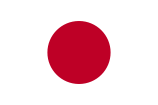 Nishinomiya, Japan since September, 1961 (Spokane's first sister city)
Nishinomiya, Japan since September, 1961 (Spokane's first sister city) Limerick, Ireland
Limerick, Ireland Jecheon, South Korea
Jecheon, South Korea Jilin, China
Jilin, China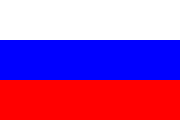 Makhachkala, Russia
Makhachkala, Russia Lübeck, Germany
Lübeck, Germany
References
- ↑ Official April 1, 2008 Washington State Population Estimates | OFM
- ↑ 2.0 2.1 "American FactFinder". United States Census Bureau. Retrieved on 2008-01-31.
- ↑ "US Board on Geographic Names". United States Geological Survey (2007-10-25). Retrieved on 2008-01-31.
- ↑ 4.0 4.1 http://www.census.gov/popest/cities/tables/SUB-EST2006-01.xls
- ↑ http://www.census.gov/population/www/estimates/metro_general/2006/CBSA-EST2006-01.xls
- ↑ Spokane Quick Facts
- ↑ http://www.ofm.wa.gov/pop/april1/default.asp
- ↑ Phillips, James W. (1971). Washington State Place Names. University of Washington Press. pp. p. 135. ISBN 0-295-95158-3.
- ↑ Meinig, D.W. (1993). The Shaping of America: A Geographical Perspective on 500 Years of History, Volume 2: Continental America, 1800-1867. Yale University Press. pp. p. 69. ISBN 0-300-05658-3.
- ↑ Kensel, W. Hudson. "Spokane: The First Decade," Idaho Yesterdays, Vol. 15, No. 1, Spring 1971.
- ↑ Frank C. Bailey Photographs - Special Collections, UW Libraries
- ↑ Spokane (city) - MSN Encarta
- ↑ [1]
- ↑ Clemence, Sara (August 30, 2005). "Safety first: The best places to live in the U.S.". MSNBC. Forbes. Retrieved on 2007-08-31.
- ↑ "Overall Best Cities". Inc. Magazine (2005). Retrieved on 2007-08-31.
- ↑ "Weatherbase". Retrieved on 2007-01-03.
- ↑ [2]
- ↑ Clemence, Sara (August 30, 2005). "Safety first: The best places to live in the U.S.". MSNBC. Forbes. Retrieved on 2007-08-31.
- ↑ "Overall Best Cities". Inc. Magazine (2005). Retrieved on 2007-08-31.
- ↑ "City Government". City of Spokane. Retrieved on 2007-08-31.
- ↑ City of Spokane - History - Economy
- ↑ Spokane: Economy - Major Industries and Commercial Activity
- ↑ City of Spokane - History - Economy
- ↑ Greater Spokane Incorporated
- ↑ Deaconess Awards and Honors, http://deaconess-spokane.org/awards.html
- ↑ WSDOT Spokane to Idaho State Line, http://www.wsdot.wa.gov/Projects/I90/SpokaneIdahoStLine/
- ↑ The Inland Empire Rail Transit Association (InlandRail)
- ↑ 2007 State Farm U.S. Figure Skating Championships named "Sports Event of the Year"
- ↑ "Bloomsday History". Retrieved on 2007-08-31.
- MacGibbon, Elma (1904). "Spokane and the Inland Empire" (DJVU). Leaves of knowledge. Washington State Library's Classics in Washington History collection. Shaw & Borden. OCLC 61326250. http://www.secstate.wa.gov/history/publications%5Fdetail.aspx?p=63.
- Stratton, David H. Spokane and the Inland Empire (Revised Edition): An Interior Pacific Northwest Anthology. Pullman, Washington: Washington State University Press, 2005. ISBN 978-0-87422-277-7
See also
- Category:Buildings and structures in Spokane
- Spokane House
- Zip's Drive In
External links
- Greater Spokane Incorporated Former Chamber of Commerce and Economic Development Council
- Spokane Public Library
- Spokane County Library District
- Spokane Night Scenes
- metro(spō-kăn') Commentary on Urban Development & Design in Spokane
- Spokane Hotels and Lodging
- Downtown Spokane Partnership
- Downtown Spokane Photos by Brad Sondahl
- Experience Spokane Visitor Resources
- Spokane Radio History by Bill Harms
- Spokane Economic Development Council
- Spokane Regional Transportation Management Center Regional Traffic Information
- Spokane Real Estate and Realtors
- Spokane Regional Convention and Visitors Bureau
- Spokane Resources, Photos, Blog and More
- Manito Park Spokane Washington Online Community
|
||||||||||||||||||||
|

